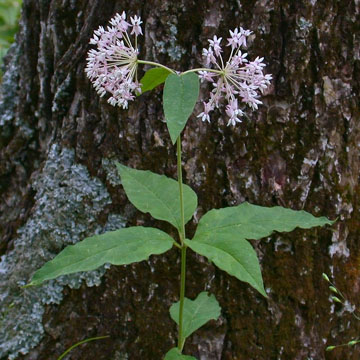

Asclepias quadrifolia - (image 1 of 4)
Taxonomy
Family: Asclepiadaceae
Habitat
Dry upland woods, usually in calcareous or circumneutral soil.
Associates
Distribution
VT to VA and in mountains to northern GA, west to southern Ontario, IL, southern IA, and OK; some disjunct populations east of the Mississippi River.
Morphology
Herbaceous perennial; stem slender, usually solitary, 20-50 cm, with 1 or 2(3) terminal and subterminal umbels, normally with three leaf-bearing nodes, the lower and upper each with a pair of small leaves, the middle with a whorl of 4 much larger ones, or the leaves rarely all opposite in four pairs; leaves thin, lanceolate or lance-ovate, the larger 6-12 cm, acuminate, cuneate to a conspicuous petiole; peduncles 1-4 cm; corolla pink to white; corolla lobes 4.5-6 mm; hoods 4-5 mm, much exceeding the gynostegium, the lateral margins bearing a prominent, sharp, inflexed tooth near or below the middle; horn flattened, sword-shaped, falcately incurved; fruit erect on erect pedicels, very slender, 8-12 cm, containing about 25-35 seeds.
Notes
Flowers June
Wetland Indicator: NA
A unique milkweed that is quite unmistakable when in flower, though difficult to identify at other times of year as the plants tend to blend in with the surrounding understory vegetation.
References
Gleason, Henry A.
and A. Cronquist. 1991. Manual of Vascular Plants of Northeastern United States
and Adjacent Canada. Second Ed.
The New York Botanical Garden. Bronx, NY
|
© Michael Hough 2018 |